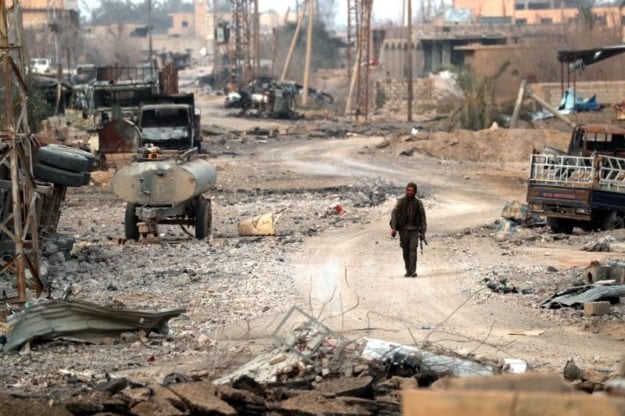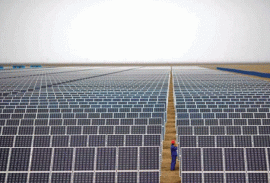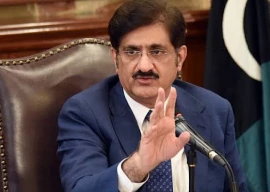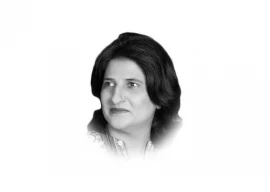
Jiya Furat said the Syrian Democratic Forces (SDF) had cornered the remaining militants in a neighbourhood of Baghouz village near the Iraqi border, under fire from all sides.
“In the coming few days, in a very short time, we will spread the good tidings to the world of the military end of Da'ish,” he said, using the Arabic acronym for Islamic State.
He was speaking after Trump said on Friday there would be 'great announcements' about Syria over the next 24 hours.
Trump on Saturday said the caliphate was "ready to fall and that the United States was asking European allies to take back more than 800 Islamic State fighters captured in Syria and put them on trial.
US pullout from Syria risks boosting Russia, Iran influence: Merkel
“The United States is asking Britain, France, Germany and other European allies to take back over 800 ISIS fighters that we captured in Syria and put them on trial,” he said in a Tweet. “The Caliphate is ready to fall. The alternative is not a good one in that we will be forced to release them...
“....The US does not want to watch as these ISIS fighters permeate Europe, which is where they are expected to go. We do so much, and spend so much - Time for others to step up and do the job that they are so capable of doing. We are pulling back after 100% Caliphate victory!”
Trump has sworn to pull US forces from Syria after Islamic State’s territorial defeat, raising questions over the fate of Washington’s Kurdish allies and Turkish involvement in northeast Syria.
As the SDF advanced under heavy US airstrikes in recent days, a stream of civilians fled the few square miles of hamlets and farmland that remain within Islamic State’s ‘caliphate’, along with defeated militants trying to escape unnoticed.
Though Islamic State fighters still hold out in a pocket of central Syria’s remote desert, and have gone underground as sleeper cells in Iraqi cities, able to launch new attacks, their territorial rule is, for now, almost over.
It ends a project launched from the great medieval mosque of Mosul in northern Iraq in 2014, when Abu Bakr al Baghdadi seized advantage of regional chaos to proclaim himself caliph, suzerain over all Muslim people and land.
He set up a governing system with courts, a currency and flag that at its height stretched from northwest Syria almost to Baghdad, encompassing some two million inhabitants.
HUMAN SHIELDS
But its reign of terror over minorities and other perceived enemies, marked by massacres, sexual slavery and the beheading of hostages, drew a forceful international military response that pushed it steadily back from 2015.
Most of the fighters left in Baghouz are foreigners, the SDF has said, among the thousands drawn by Baghdadi’s promise of a new mlitant utopia straddling the Iraqi-Syrian border and expunging national borders.
All that remains, said Furat, is an encircled pocket some 700 meters square. “Thousands of civilians are still trapped there as human shields,” he said.
The UK-based Syrian Observatory for Human Rights said the SDF had taken control of all of Baghouz after the militants there surrendered. SDF officials denied this.
Syrian conflict: Militant defeat, US pullout on table at coalition talks
Spokesman Mustafa Bali said the SDF had caught several militants trying to flee among the civilians. Others had handed themselves over.
Their fate, and that of their families, has befuddled foreign governments, with few ready to repatriate citizens who pledged allegiance to a group sworn to their destruction, but who might be hard to legally prosecute. The SDF does not want to hold them indefinitely.
The fate of Baghdadi is also a mystery. He has led the group since 2010, when it was still an underground al Qaeda offshoot in Iraq.
STILL A THREAT
Its capacity then for strategic retreats in hard times, followed by rebounds when circumstances changed, has prompted numerous warnings that Islamic State’s defeat has not ended the threat it poses to the region.
Islamic State suffered crippling defeats in 2017, when Iraq recaptured Mosul, the SDF seized its Syrian capital of Raqqa, and the Damascus government pushed it east to the Euphrates.
But in Iraq it has switched to guerrilla hit-and-run tactics, aimed at undermining the Baghdad government. It has also claimed responsibility for a series of bombings in swathes of northeast Syria held by the SDF, including one last month that killed four Americans.
That attack came soon after Trump pledged to pull out, saying Islamic State was already defeated, rattling allies and prompting defense secretary Jim Mattis to resign.
Turkey, which regards the SDF’s strongest component, the Kurdish YPG, as terrorists, has threatened to march deeper into northern Syria to drive it back.
On Friday U.S. Army General Joseph Votel, who oversees U.S. forces in the Middle East as head of Central Command, said the end of the territorial caliphate would lead to a more dispersed, harder-to-detect network of fighters waging guerrilla warfare.
That should require continued help from Washington, he said.


1727142053-0/Jacob-Erodi-(3)1727142053-0-165x106.webp)




















COMMENTS
Comments are moderated and generally will be posted if they are on-topic and not abusive.
For more information, please see our Comments FAQ